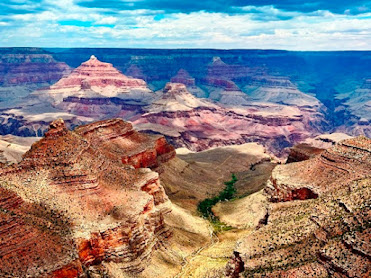If you want to live to 100, consider taking up residence in
the mountainous interior of Barbados. Clean air—no pollution, even though it is
windy--fresh foods, and plenty of exercise have produced the largest number of
centenarians per capita after Japan. (Since October 2010, the entire island has
been smoke-free).
Called the Scotland District because it resembles the Scottish Highlands, this is a beautiful but fragile region with undulating topography. Because of how it rose from the sea 500,000 years ago, Barbados has a terraced landscape with many ridges. While this makes for great views from most locations, houses built on the edge of ridges are in danger of tumbling into the ocean from erosion, so the soil must be shored up in many places with wire-enclosed rocks.
This picturesque region on the east coast of Barbados was one stop on a four-hour photography tour led by renowned Barbadian photographer Ronnie Carrington. “Part of the uniqueness of Barbados is the way the island’s beauty emerges as you drive into the countryside,” Carrington observed. Although sugar cane farming has declined in recent years, the mosaic of green cane fields interspersed with small serene villages is still a dominant feature of the island. And wherever you see a church in the villages, there is a rum shop within walking distance.
We started our journey down Spring Garden Street, a major artery in Bridgetown, the capital of Barbados. The first photo stop was at the entrance to a large plantation where tall cabbage palm trees provided a symmetrically landscaped path to the estate house.
On the second stop, Carrington showed us a chattel house, created for easy dismantling when families moved to another location—a common practice in past years. He explained that chattel houses feature high-pitched gabled roofs without eaves, enabling them to withstand high winds common in the hurricane belt. The door is always centered with jalousie-shuttered windows on each side. Our photos captured a slice of Barbadian history as only a few of these architectural oddities remain.
Wind was the dominant feature of the Cambridge area, but photos from Windy Ridge revealed stunning views of the sea. Soil is composed of sandstone and clay, while long-ago upheavals were evident in abundant sharp, pointed rock formations.
Barclay’s Park on the beach was also very windy, although being at sea level meant wind was less than on the Ridge. We couldn’t stop snapping different views of gorgeous blue water, luscious green sea plants, gnarled trees, and blooming bougainvillea and hibiscus.
No visit to Barbados is complete without sampling rum punch, which we did at Sea Side Bar in the Bathsheba region. Here pock-marked rocks, which surfaced when Barbados was pushed up from the ocean floor, are scattered around the shoreline and poke up above waves off-shore.
Tourism sustains the economy of Barbados, although the island retains a “real Caribbean” feel. Hiking and diving, plus tours of seaside villages, plantations, gardens, and 17th century English country churches make Barbados a great place for adventure or relaxation. If you plan a visit, you’ll appreciate that trade winds keep the temperature steady at 75 to 85 degrees.
Photos by Larry and Beverly Burmeier



























































